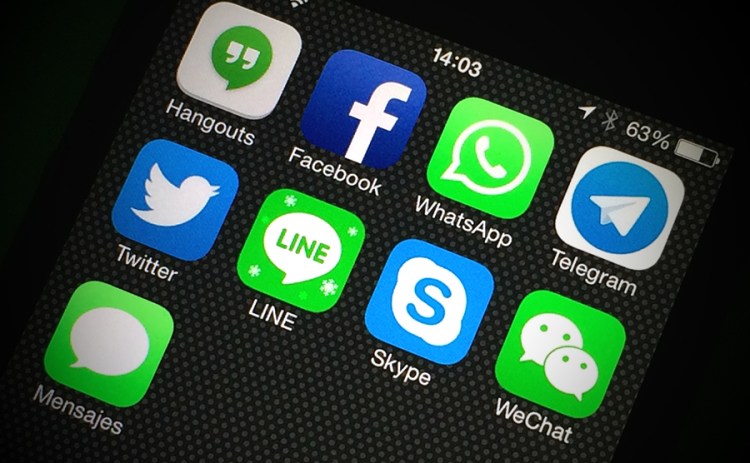There’s a deep shift in the way we communicate happening, and it’s about to turn media and marketing businesses upside-down.
In short, the Web-based world is about to become secondary to the message-based world.
Messaging apps like WhatsApp (now part of Facebook), WeChat, Line, Snapchat, and Kik are sitting pretty in this new world. That’s because they’re the apps that young people increasingly use to communicate. Some striking stats:
- WhatsApp: 700 million monthly active users
- WeChat: 468 million monthly active users
- Line: 181 million monthly active users
- SnapChat: 100 million monthly active users
- Tango: 70 million monthly active users
Kik, whose cofounder and chief technical officer Chris Best was on a panel discussion with me earlier this week, doesn’t report monthly active users for some reason. Instead, it reports that it has 200 million registered users — of which some unknown, smaller proportion are active users. Tango also reports 200 million registered users, so we can estimate that Kik, like Tango, probably has about 1/3 as many active users, or about 70 million.
But Kik claims that 40 percent of people in the U.S. between the ages of 13 and 25 have Kik accounts. Forty percent! That’s an astonishing number that gives some hint of how ubiquitous messaging apps are becoming.
At first glance, you might wonder what the big deal is. Why does anyone need one of these apps to communicate when we’ve already got email, instant messengers from Facebook, Google or AOL, and SMS-based text messages?
The answer is complex, but boils down — I think — to the fact that these message apps let people create unique identities that aren’t tied to their email accounts or phone numbers, and they support a wider range of content. You can send funny GIFs to your friends. You can send them custom stickers. You can send them goofy selfies that (usually) disappear in a few seconds. You can play games with them.
And, increasingly, you can read the news or make purchases via message apps.
In this, the U.S. is a bit behind Asia, where you can even buy insurance and apply for a mortgage via WeChat. But transactional features are coming to our shores.
And content: Snapchat’s move into content, with its Snapchat Discover channel, is just the start.
And search: As NYC Techstars’ Alex Iskold recently wrote, I’ve seen the future of search, and it ain’t Google.
And even more: One new startup out of Y Combinator called Magic is promising to fulfill whatever it is you need — whether that’s a pizza and a Pepsi, an order of sushi and some flowers, or a tiger. Magic works via SMS right now, but it’s easy to imagine it working in any of the major messaging apps.
Web- and content-based businesses, like Google and Facebook, will have to recalibrate their entire business models. (Facebook seems to understand this, and was willing to spend an enormous amount, $22 billion, in acquiring WhatsApp as a hedge against this message-centric future.) That goes double for publishers like Yahoo, Buzzfeed, Vox Media, the New York Times, and, yes, VentureBeat.
Apps that aren’t message-centric will need to transform themselves, or else find a way to insert themselves into the message economy somehow. Instagram’s recent direct message feature is a perfect example of a content-centric app trying to turn itself into a messaging app.
For marketers, messaging apps are incredibly tempting — and potentially revolutionary. Kik, for instance, says that 70 percent of the branded messages it has sent to its users are opened in the first hour, an enormous open rate. That’s not based on a small sample size, either: It has sent 100 million of these messages to date. What’s more, it says that the click-through rates on those messages are 10 to 50 times higher than on Twitter or Facebook. The reason it’s seeing such high rates of engagement are because people have already opted-in to receive those message. If you’re following Funny or Die (a content partner on Kik), you’ve already self-selected as someone who is interested in that brand’s content. Also, Kik limits marketers to just four branded messages per month, to help keep the frequency low and the novelty high.
Other message-centric apps are taking different approaches. WhatsApp claims that it will not carry advertising — though that’s the fundamental raison d’etre for its parent company, Facebook, so we’ll see how long that lasts. Snapchat has just started to experiment with making money. WeChat hasn’t made nearly the traction here that it has seen in Asia, and offers fewer features to its English-speaking users (and marketers). Tango has been aggressively courting game developers.
Whatever approaches win out, one thing seems clear: Message apps are flush with cash, and know that they’re sitting on top of an incredibly valuable resource — the time and attention of a young and tech-savvy demographic. Look for a lot of experimentation to happen in the next year or two.
And who knows, maybe the next big media brand will emerge on a messaging app instead of on the Web.
VentureBeat's mission is to be a digital town square for technical decision-makers to gain knowledge about transformative enterprise technology and transact. Learn More

